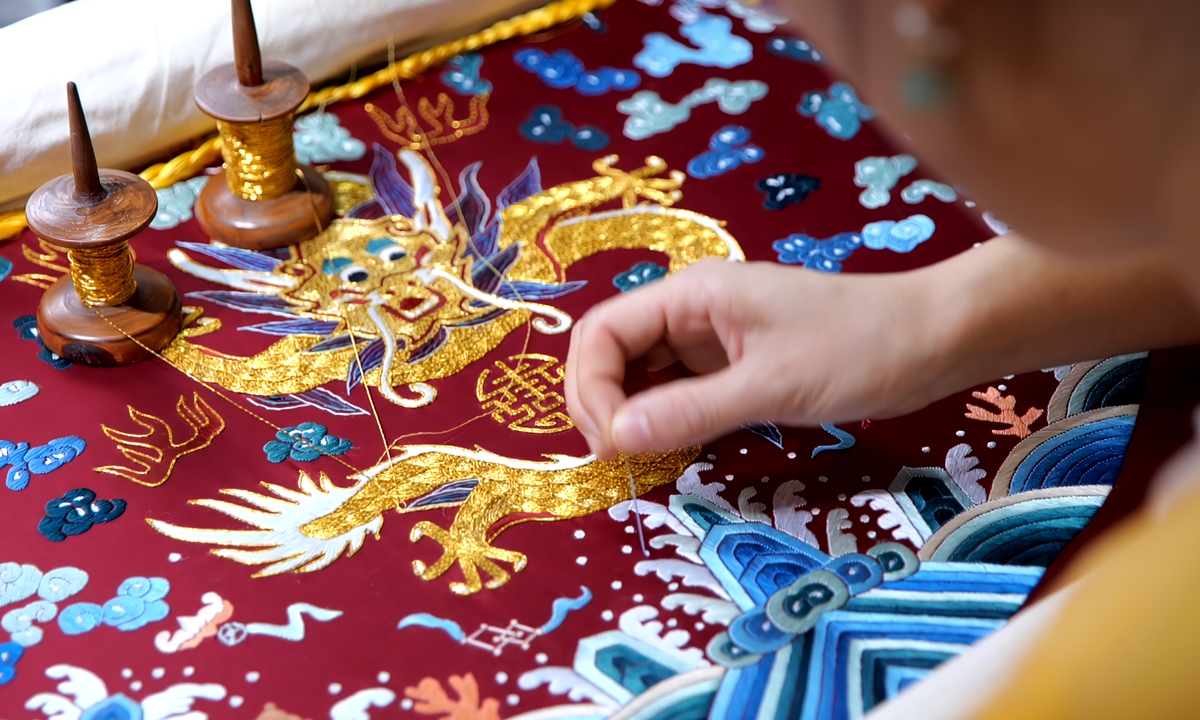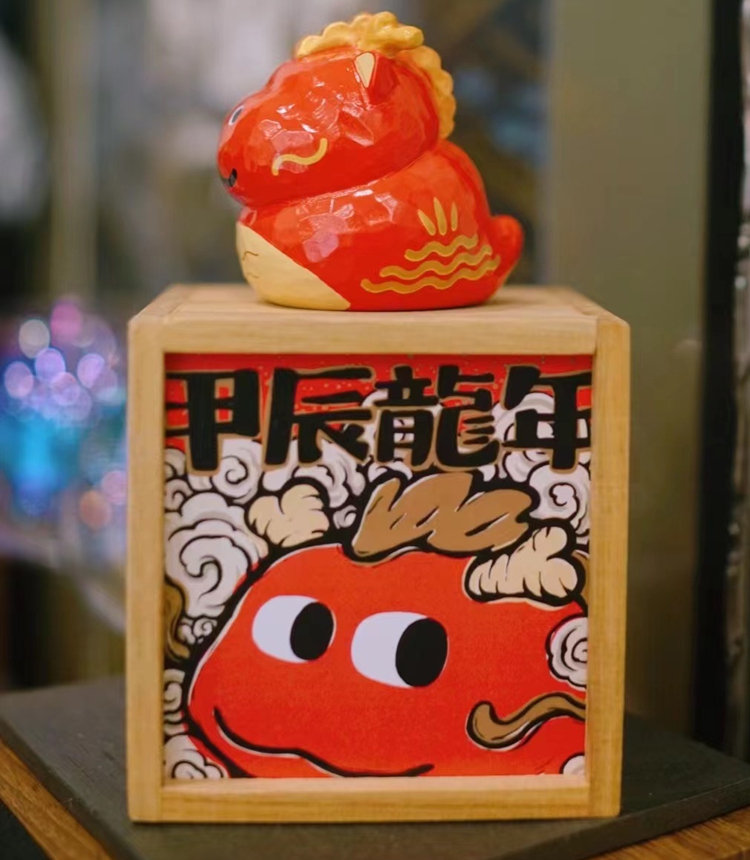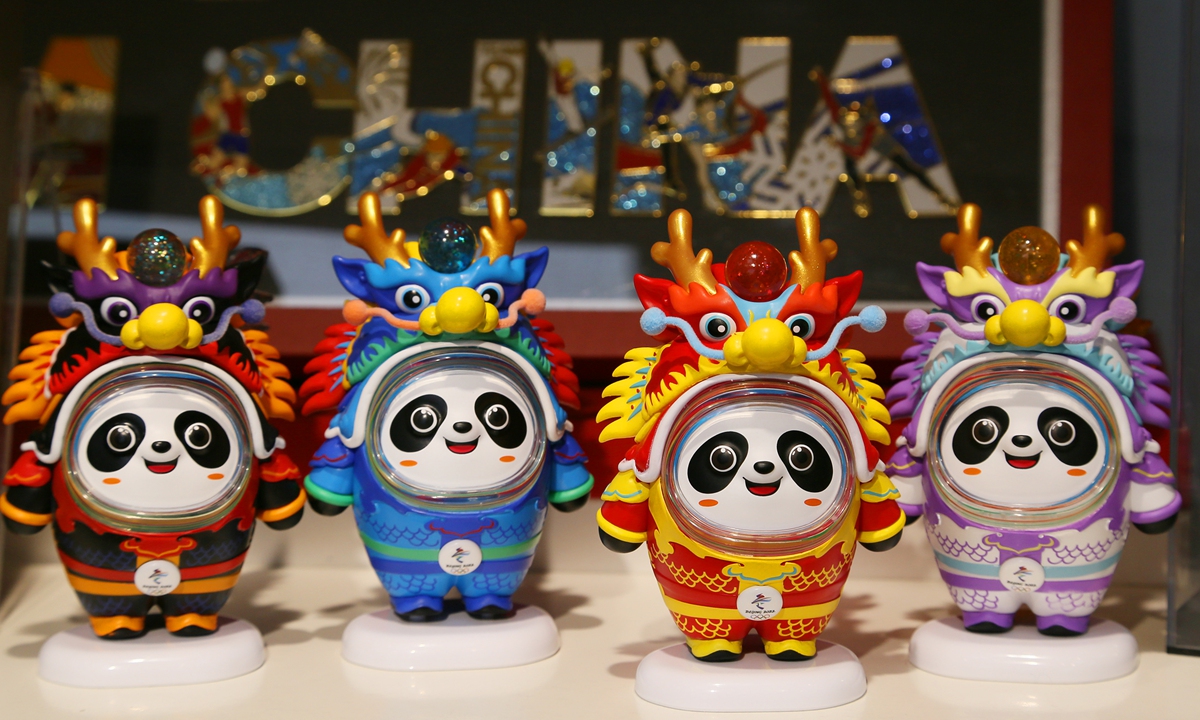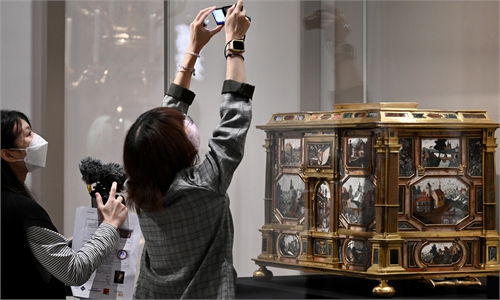ARTS / CULTURE & LEISURE
Time-honored totem dragon takes on more meaning in modern day via reinvention of cultural legacy
Time-honored totem takes on more meaning in modern day via reinvention of cultural legacy

A piece of Beijing Embroidery portraying a Chinese dragon Photo: Courtesy of Tian Peng
With the advent of the Year of the Dragon in the Chinese calendar, the Oxford English Dictionary (OED) has, for the first time, included the term "Chinese dragon" in its lexicon.The Chinese dragon has two definitions in the OED, with the first one about its physical image and the second one on its figurative and allusive nature.
Emperors and high-ranking officials in ancient dynasties were invariably dressed in a Dragon Robe, a traditional silk-woven garment richly embroidered with dragon designs. The robe features intricate dragon motifs, symbolizing imperial power and authority. The level of detail in the embroidery often reflects the wearer's rank and status.
Jade seals, another artifact that symbolizes the supreme authority of the emperor, were often engraved with dragons or shaped like the auspicious symbol.
Contrary to the Western dragon, the image of the Chinese dragon, despite undergoing constant changes, has represented various positive qualities including prosperity, authority, strength, good fortune and vigor.
In ancient Chinese belief, dragons were associated with the control of the weather, particularly rain. The dragon's ability to bring rain was seen as crucial for agriculture, making it a positive symbol for the fertility of the land.
The creatures are deeply ingrained in Chinese mythology and folklore, often depicted as wise, powerful, and benevolent beings, and no traditional festival is complete without an undulating dragon dance.
Regarding the festive goods people purchase in celebration of the Chinese New Year, dragon-themed products have made headlines and sold like hotcakes.
Riding on the wave of this festive consumption, the inheritor of a national-level intangible cultural heritage has partnered with brands in a fresh effort to present the enduring totem to the public.
With the rising China Chic trend and the country's booming cultural creative industry, the Chinese dragon in folklore is now commonly seen in creative products such as tear-off calendars, dolls, dragon-themed jewelry as well as the "dragon blind boxes" that appeal to young consumers.
No matter if it is through the hands of a national-level intangible cultural heritage inheritor or the hands of a Generation Z "blind box" designer, the Chinese dragon carries forward the Chinese cultural spirit.
Beijing Embroidery, or imperial embroidery, is one of the eight exquisite handicrafts of Beijing and was once honored as one of the "four major embroidery categories" along with Suzhou Embroidery, Hunan Embroidery and Gu Embroidery. Many Beijing embroidery products are treasured in the Palace Museum and Beijing Art Museum.
Coming of age during the Ming (1368-1644) and Qing (1644-1911) dynasties, the craftsmanship was used to make luxurious imperial robes with silk and gold thread, symbolizing wealth and power.
The image of the dragon is a major element of the handicraft and exudes a royal aura with bright colors.
Tian Peng, an inheritor of Beijing Embroidery, told the Global Times that the embroidery pieces are more than artworks, as they also serve as symbols carrying the rich cultural traditions of the Chinese nation.
"The portrayal of the dragon in Beijing Embroidery goes beyond being a mere design but represents the inheritance and expression of Chinese culture. It symbolizes national prosperity, people's well-being, and favorable weather conditions," Tian said.
The dragon image in Beijing Embroidery is both majestic and vibrant, with distinct dragon scales, clearly visible whiskers, and sharp claws. Various techniques such as flat stitching and insertion stitching are employed in production, giving the dragon a three-dimensional and smooth appearance, Tian noted.
Dragon works typically feature bright and contrasting colors such as red, gold, blue and black, symbolizing happiness, nobility power and dignity, respectively. Embroiderers use a rich palette to reflect the dragon's dignity and mystery, adhering to traditional dragon symbolism while maintaining a noble quality.
Comparing to other embroidery, a combination of various stitching techniques is employed to achieve a realistic effect with complementary patterns like cloud and water motifs, which adds a sense of depth and dynamism to the artwork.
"In creating the image of a dragon, Beijing Embroidery emphasizes on symmetry and harmony, aligning with the aesthetics of traditional Chinese art. The symmetric patterns make the artwork more rigorous and balanced and the three-dimensional image enhances the prominence and vividness of the dragon," said the fifth-generation heir of the craftsmanship.
Facing a shortage of young inheritors, Tian said he has been trying to integrate traditional craftsmanship into contemporary art and working on innovative designs in partnership with other heritages to arouse the interest of the younger generation.
This cross-disciplinary collaboration yielded a limited edition gift package for the Year of the Dragon featuring a bottle of liquor, a handheld ceramic dragon ornament and a dragon embroidery artwork.
"We hope the package brings happiness and good fortune to people in the Year of the Dragon," said Tian.
Meanwhile, the image of the Chinese dragon has also been reinterpreted by cultural creative industry practitioners to meet the tastes of more young people.

A dragon blind box Photo: Courtesy of designer Big Orange
Fashion iconHelping the boom in China's cultural creative industry is the fact that nearly 50 percent of consumers value a product's "collectible value" and "symbolic meaning" besides its practical function and price.
This fact from an iiMedia Research report reveals that the essence of Chinese culture is still a deciding factor for today's creative products. The time-honored totem of the Chinese dragon is a hot IP that meets consumers' cultural appetites.
Followed by more than 160,000 fans on China's social media site Sina Weibo, a cultural creative product designer known as the "Big Orange" has recently launched his "dragon blind boxes."
The designer's dragon character is hand-sculpted from wood. He gives a "red skin" to the character to match up with the jolly ambiance of the Spring Festival. Unlike many ancient aesthetic interpretations of the dragon that often depict long beards, golden scales and solemn big eyes, Big Orange's dragon appears to be much simpler with a round body and eyes that look shy and cute.
The designer told the Global Times that he has deliberately simplified the character to "make viewers feel it is a lovely pet that brings them happiness."
"The simple design and cuteness reduce the unapproachable solemnity of the dragon and is in line with the aesthetic tastes of today's consumers, so that dragon culture can be better integrated into their lives," the designer told the Global Times.
Not only the aesthetics, but the "blind box" format of production demonstrates the cultural creative industry's unique strategy to pique consumers' curiosity, especially young consumers. Including the dragon, Big Orange told the Global Times that his "12 Chinese zodiac animal signs" blind box collection is one of his career highlights and his goal is to get young people engaged in Chinese wisdom.
What does it suggest when the Chinese dragon, a cultural totem of the nation that is thousands of years old, becomes cuter?
Cultural sociologist Xu Shuming told the Global Times that it shows the "new generation's continued imagination and interest in their cultural tradition" as well as the "creative freedom" brought by the enlarging Chinese cultural consumption market.
"It is a 'one plus one equals two' equation: young people's cultural confidence plus the market's growth leads to diverse dragon interpretations," said Xu.

The Year of the Dragon version of Beijing 2022 Winter Olympics mascot Bing Dwen Dwen Photo: VCG
A bridge for cultureThe contemporary Chinese dragon is a lively example that shows how a traditional element can be revived through "cooperation with multiple important organs in the cultural industry," Yao Yu, a cultural creative industries researcher, told the Global Times.
Museums are one of those "cultural organs" that can help spread Chinese dragon culture. Take the National Museum of China, for example. It has recently launched a five-color dragon brooch.
The brooch's design was inspired by the unique "dragon" aesthetics of China's Ming Dynasty, during which the dragon often looked fierce and courageous. Besides the brooch, the museum has also launched a neck pillow featuring the Hongshan culture's dragon aesthetics, which sees the dragon gain an elegant silhouette.
Those Chinese dragon aesthetics from different periods reveal how China's ever-evolving culture can increase the aesthetic diversity of modern products.
"I bought a whole basket of these assorted dragon brooches because they are all uniquely different and I can feel China's approachable and lovable history," a consumer surnamed Xu remarked.
The Chinese cultural spirit shines through its historical dragon symbol. Aside from domestic museums, overseas cultural facilities such as the Metropolitan Museum of Art (The MET) in New York have also dedicated a new exhibition to the most celebrated symbol in Chinese culture.
From February 10, the first day of the Year of the Dragon, a remarkable selection of more than 20 artifacts about the Chinese dragon covering porcelains, jade, lacquer and textiles will be on display for visitors to the museum.
Including a jade pendant made in the third century BC and a bronze mirror from the seventh century, those artifacts not only speak to the beauty of China, but also act as a bridge to connect Westerners to this representative of ancient Chinese socio-cultural beliefs and rituals.
The MET is not the only example. The Louvre Abu Dhabi once launched another exhibition to contextualize the Chinese dragon in "phoenix" culture. Through the display of 240 masterpieces, the cultural landscape of the centuries of exchanges between the Chinese and Islamic worlds was revealed to visitors.
Today, the Chinese dragon is no longer just about China. It has become a symbol of the world's shared humanity and the convergence between the East and the West.
While working hard at her studio from 8 am to 10 pm to prepare her latest "Streaming Dragon" jewelry collection, Chinese designer Yan Mengya told the Global Times that she was excited and confident to present this collection at an international jewelry fair in Nice, France, in June.
"I co-designed this collection with a local artist in France. She visited China and was impressed by the C-shaped jade dragon discovered in North China's Inner Mongolia Autonomous Region. She was surprised about how incredibly modern the sculpture looks despite its long history. The dragon artifact made her see the profundity of Chinese craftsmanship and Chinese culture," Yan told the Global Times.


